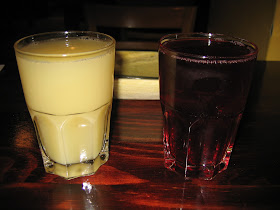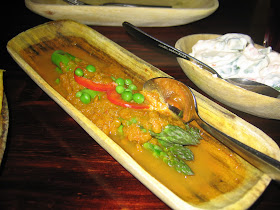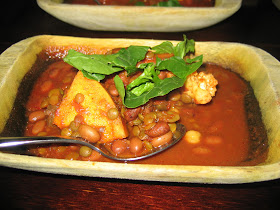I can’t believe it’s 2007! This is a big year for me. In eight weeks I’ll be getting married! Ahhhh!!!
Last night I had Tim W and Jane over for dinner and when I opened the front door there was one extra person: my little sister Amy!
She was supposed to be in South Africa on the last leg of her 2½ year journey abroad. After visiting 23 countries in Asia, Europe, Africa and the Middle East, she came home early and surprised me – just in time to celebrate the new year together!
To start the first Recipe Carousel of 2007 I’ve chosen something that starts the day for many people around the world: milkshakes.
Smoothies, frappes and milkshakes are a wonderful drink at breakfast, lunch or dinner and there’s such a huge potential of ingredients and ideas.
Here’s seven that tickled my fancy in one way or another.
Avocado Milkshake. Melissa in Scotland (The Traveler's Lunchbox) has discovered one of South East Asia’s delightful and rich drinks. Avocado flesh is blended with milk, sweetened condensed milk and flavoured with your choice of orange extract, vanilla, rum or coffee. Don’t be frightened by this combination, many who have sipped this drink have raved about the avocado’s ability to transform into a creamy dessert companion.
Cherry Yoghurt Milkshake is a gorgeously pink drink from Zorra in Spain (Kochtopf). Yoghurt is blended with canned cherries, lemon juice, honey and cinnamon. Throw in a dash of the cherry syrup and you’ve got yourself one quick and easy shake to get your motor running.
Chocolate Drinks were enjoyed by Keiko in the UK (Nordljus). She made chocolate ice cubes served vanilla milk, the chocolate and milk amalgamating as the chocolate melted. She suggests the drink could be modified to add spices or even a little coffee to the mix.
Iced Coffee with Sticky Rice Balls is a classic Thai drink from Appon (Appon's Thai Food). Espresso is blended with sugar and milk then chilled. Meanwhile sticky rice flour is coloured and flavoured with rosewater then boiled in ball shapes. These are simply added to the iced coffee and sucked up through large straws. Photo courtesy of Appon.
Pineapple Frullato is a spring time recipe from Orchidea in Sweden (Viaggi & Sappori). Her quick and easy recipe combines fresh juicy pineapple with natural yoghurt and Italian acacia honey. A non fuss way to toast to primavera.
Fig & Honey Smoothie is a recipe road test by Michèle in France (Oswego Tea). I recognised this recipe from a Michele Cranston book I have at home and sure enough, this is where Michèle sourced it from. Black figs are blended with natural yoghurt and, in Michèle’s case, rosemary honey. The final product is topped with toasted slivered almonds.
Berry Smoothies are a simple dairy treat from Priya in the USA (Sugar and Spice). In her recipe you can used either fresh or frozen berries and blend them with milk, yoghurt, orange juice and honey. Priya also suggests that wheatgerm or flaxseed can be added to increase nutritional benefits and cow milk can be substituted for soy milk.
I have some of my own milkshake recipes, including horchata and lemony nimbu lassi, as well as the alcoholic Coco Baby Bitters, Pink Pudding and Boozy Hot Chocolate.
Add your own recipe!
If you want to link in your own milkshake recipe and share the love around, just leave the link in the comments section. You didn’t have to invent the recipe yourself, just make it and post it on your site. The whole idea of Recipe Carousel is that good recipes are shared with people who love to cook.
Note: Usual comments are more than welcome but all html links must be recipe related (yours or others).
Check out other Recipe Carousel themes: rice, festive food, legumes/pulses, eggs, pancakes, breakfast, raw food, berries, dips, cocktails, pasta, yoghurt, crispy snacks, vegetable desserts, fruit in savoury food, made from scratch, strawberries, jam, bread, seafood mains, ice cream, soup, chocolate and drinks.
Tags: morsels and musings food blog food and drink australia recipes recipe carousel breakfast breakfast recipes drinks drink recipes milkshakes milkshake recipes smoothies milk yoghurt berries coffee pineapple fig honey chocolate avocado cherry
























